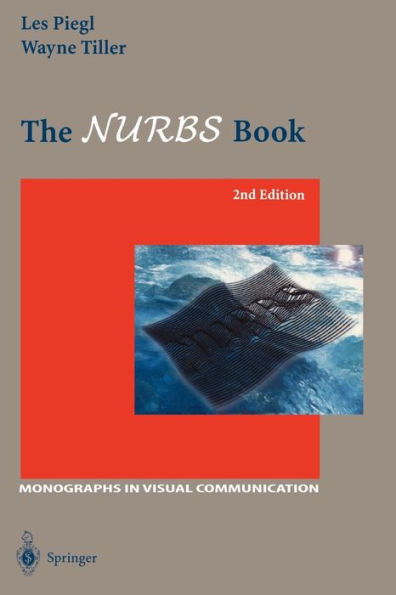5
1
9783540615453


$99.99

The NURBS Book / Edition 2 available in Paperback

- ISBN-10:
- 3540615458
- ISBN-13:
- 9783540615453
- Pub. Date:
- 11/14/1996
- Publisher:
- Springer Berlin Heidelberg
- ISBN-10:
- 3540615458
- ISBN-13:
- 9783540615453
- Pub. Date:
- 11/14/1996
- Publisher:
- Springer Berlin Heidelberg

Paperback
Buy New
$99.99Buy Used
$63.13
$99.99
-
-
SHIP THIS ITEM
Temporarily Out of Stock Online
Please check back later for updated availability.
-
99.99
In Stock
Overview
Until recently B-spline curves and surfaces (NURBS) were principally of interest to the computer aided design community, where they have become the standard for curve and surface description. Today we are seeing expanded use of NURBS in modeling objects for the visual arts, including the film and entertainment industries, art, and sculpture. NURBS are now also being used for modeling scenes for virtual reality applications. These applications are expected to increase. Consequently, it is quite appropriate for The.N'URBS Book to be part of the Monographs in Visual Communication Series. B-spline curves and surfaces have been an enduring element throughout my pro fessional life. The first edition of Mathematical Elements for Computer Graphics, published in 1972, was the first computer aided design/interactive computer graph ics textbook to contain material on B-splines. That material was obtained through the good graces of Bill Gordon and Louie Knapp while they were at Syracuse University. A paper of mine, presented during the Summer of 1977 at a Society of Naval Architects and Marine Engineers meeting on computer aided ship surface design, was arguably the first to examine the use of B-spline curves for ship design. For many, B-splines, rational B-splines, and NURBS have been a bit mysterious.

Product Details
| ISBN-13: | 9783540615453 |
|---|---|
| Publisher: | Springer Berlin Heidelberg |
| Publication date: | 11/14/1996 |
| Series: | Monographs in Visual Communication |
| Edition description: | 2nd ed. 1997 |
| Pages: | 646 |
| Product dimensions: | 6.10(w) x 9.25(h) x 0.24(d) |
Table of Contents
One Curve and Surface Basics.- 1.1 Implicit and Parametric Forms.- 1.2 Power Basis Form of a Curve.- 1.3 Bézier Curves.- 1.4 Rational Bézier Curves.- 1.5 Tensor Product Surfaces.- Exercises.- Two B-Spline Basis Functions.- 2.1 Introduction.- 2.2 Definition and Properties of B-spline Basis Functions.- 2.3 Derivatives of B-spline Basis Functions.- 2.4 Further Properties of the Basis Functions.- 2.5 Computational Algorithms.- Exercises.- Three B-spline Curves and Surfaces.- 3.1 Introduction.- 3.2 The Definition and Properties of B-spline Curves.- 3.3 The Derivatives of a B-spline Curve.- 3.4 Definition and Properties of B-spline Surfaces.- 3.5 Derivatives of a B-spline Surface.- Exercises.- Four Rational B-spline Curves and Surfaces.- 4.1 Introduction.- 4.2 Definition and Properties of NURBS Curves.- 4.3 Derivatives of a NURBS Curve.- 4.4 Definition and Properties of NURBS Surfaces.- 4.5 Derivatives of a NURBS Surface.- Exercises.- Five Fundamental Geometric Algorithms.- 5.1 Introduction.- 5.2 Knot Insertion.- 5.3 Knot Refinement.- 5.4 Knot Removal.- 5.5 Degree Elevation.- 5.6 Degree Reduction.- Exercises.- Six Advanced Geometric Algorithms.- 6.1 Point Inversion and Projection for Curves and Surfaces.- 6.2 Surface Tangent Vector Inversion.- 6.3 Transformations and Projections of Curves and Surfaces.- 6.4 Reparameterization of NURBS Curves and Surfaces.- 6.5 Curve and Surface Reversal.- 6.6 Conversion Between B-spline and Piecewise Power Basis Forms.- Exercises.- Seven Conics and Circles.- 7.1 Introduction.- 7.2 Various Forms for Representing Conics.- 7.3 The Quadratic Rational Bézier Arc.- 7.4 Infinite Control Points.- 7.5 Construction of Circles.- 7.6 Construction of Conies.- 7.7 Conic Type Classification and Form Conversion.- 7.8 Higher Order Circles.- Exercises.- Eight Construction of Common Surfaces.- 8.1 Introduction.- 8.2 Bilinear Surfaces.- 8.3 The General Cylinder.- 8.4 The Ruled Surface.- 8.5 The Surface of Revolution.- 8.6 Nonuniform Scaling of Surfaces.- 8.7 A Three-sided Spherical Surface.- Nine Curve and Surface Fitting.- 9.1 Introduction.- 9.2 Global Interpolation.- 9.2.1 Global Curve Interpolation to Point Data.- 9.2.2 Global Curve Interpolation with End Derivatives Specified.- 9.2.3 Cubic Spline Curve Interpolation.- 9.2.4 Global Curve Interpolation with First Derivatives Specified.- 9.2.5 Global Surface Interpolation.- 9.3 Local Interpolation.- 9.3.1 Local Curve Interpolation Preliminaries.- 9.3.2 Local Parabolic Curve Interpolation.- 9.3.3 Local Rational Quadratic Curve Interpolation.- 9.3.4 Local Cubic Curve Interpolation.- 9.3.5 Local Bicubic Surface Interpolation.- 9.4 Global Approximation.- 9.4.1 Least Squares Curve Approximation.- 9.4.2 Weighted and Constrained Least Squares Curve Fitting.- 9.4.3 Least Squares Surface Approximation.- 9.4.4 Approximation to Within a Specified Accuracy.- 9.5 Local Approximation.- 9.5.1 Local Rational Quadratic Curve Approximation.- 9.5.2 Local Nonrational Cubic Curve Approximation.- Exercises.- Ten Advanced Surface Construction Techniques.- 10.1 Introduction.- 10.2 Swung Surfaces.- 10.3 Skinned Surfaces.- 10.4 Swept Surfaces.- 10.5 Interpolation of a Bidirectional Curve Network.- 10.6 Coons Surfaces.- Eleven Shape Modification Tools.- 11.1 Introduction.- 11.2 Control Point Repositioning.- 11.3 Weight Modification.- 11.3.1 Modification of One Curve Weight.- 11.3.2 Modification of Two Neighboring Curve Weights.- 11.3.3 Modification of One Surface Weight.- 11.4 Shape Operators.- 11.4.1 Warping.- 11.4.2 Flattening.- 11.4.3 Bending.- 11.5 Constraint-based Curve and Surface Shaping.- 11.5.1 Constraint-based Curve Modification.- 11.5.2 Constraint-based Surface Modification.- Twelve Standards and Data Exchange.- 12.1 Introduction.- 12.2 Knot Vectors.- 12.3 Nurbs Within the Standards.- 12.3.1 IGES.- 12.3.2 STEP.- 12.3.3 PHIGS.- 12.4 Data Exchange to and from a NURBS System.- Thirteen B-spline Programming Concepts.- 13.1 Introduction.- 13.2 Data Types and Portability.- 13.3 Data Structures.- 13.4 Memory Allocation.- 13.5 Error Control.- 13.6 Utility Routines.- 13.7 Arithmetic Routines.- 13.8 Example Programs.- 13.9 Additional Structures.- 13.10 System Structure.- References.From the B&N Reads Blog
Page 1 of
